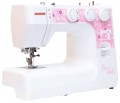Adjustments
—
Регулировка давления лапки. Возможность изменять степень давления лапки на ткань, подстраивая ее под толщину материала: для тонких тканей (шифон, трикотаж) давление должно быть небольшим, для толстых — наоборот.
—
Регулятор натяжения нити. Приспособление, позволяющее регулировать степень натяжения верхней нити. Несогласование по натяжению между верхней и нижней нитью приводит к тому, что одна из ниток вытягивает другую и шов портится; для избежания этого явления и предусматривается данная функция. Отметим, что регулировка натяжения возможна и для нижней нити — она осуществляется через челнок (такую возможность имеют все челноки). Но для этого необходимо вынимать шпульный колпачок, а то и весь челнок целиком. Верхний же регулятор располагается прямо на корпусе машинки, и пользоваться им значительно проще.
—
Стабилизатор усилия прокола. Приспособление, которое обеспечивает стабильное усилие прокола независимо от скорости работы двигателя. Особенность механики электродвигателей заключается в том, что без специальной регулировки усилие прокола заметно снижается при росте оборотов. Данная же функция позволяет поддерживать приблизительно одинаковый уровень на всем диапазоне скоростей, что положительно сказывается на качестве работы.
—
Отключение нижнего транспортера. Возможность отключить нижний транспортер машинки. Д
...анная особенность незаменима для работ, при которых ткань нужно смещать вручную — например, вышивки по сложному контуру на машинке без вышивального блока, пришивании пуговиц и т.п.
— Ограничитель скорости. Возможность задать ограничение по скорости работы машинки. Благодаря этой функции можно не бояться «пережать» педаль — даже при сильном нажиме машинка будет работать с заданной скоростью, и не быстрее. Данная особенность бывает полезна, в частности, при работах, где требуется внимательно контролировать процесс.
— Коленный рычаг подъема лапки. Приспособление, позволяющее поднимать лапку и опускать нижний транспортер движением колена, не снимая рук с ткани. Такое приспособление бывает полезно при квилтинге и некоторых разновидностях вышивки.Presser foots
Виды лапок, поставляемых в комплекте со швейной машинкой.
— Универсальная. Лапка, используемая для стандартных швейных операций — преимущественно прямых строчек и зигзагов.
—
Лапка оверлочная. Лапка, предназначенная для выполнения оверлочной обработки. По определению встречается в устройствах с функцией оверлока (см. «Тип»), однако может предусматриваться и в традиционных швейных машинках. В последнем случае такая лапка, разумеется, не заменит полноценного оверлока, однако в некоторых ситуациях она позволяет обойтись без него.
—
Верхний транспортер ткани. Дополнительный транспортер для ткани, устанавливаемый сверху, вместо штатной лапки в дополнение к стандартному нижнему транспортеру. Такое приспособление облегчает работу с тонкими, деликатными и скользящими тканями, а также сшивание вместе нескольких слоев ткани: материал сдвигается максимально равномерно, без перекосов и смещений.
—
Лапка для вшивания молнии. Лапки для вшивания молнии могут иметь разный размер и конструкцию — в частности, существуют специальные приспособления для вшивания потайной молнии. Конкретные особенности данного приспособления стоит уточнять отдельно.
—
Лапка для декоративной строчки. Лапки, предназначенные для различных разновидностей декоративной строчки. Такая строчка может и не иметь функциональной
...роли, ее основная задача — подчеркнуть определенный элемент одежды (края, карманы, отдельные швы и т. п.). В любом случае линия стежков обычно должна строго следовать контуру, вдоль которого она наносится — а этот контур может состоять как из прямых, так и из кривых линий. Специальные лапки для декоративной строчки упрощают задачу: они оснащаются линейками или другими приспособлениями, позволяющими контролировать параллельность стежков.
— Лапка для атласной строчки. Данная лапка будет пригодна для аппликаций и другой работы, где часто используется зигзагоподобные стежки.
— Лапка для потайной строчки. Лапка, предназначенная для потайных швов, применяемых при подгибании края ткани. Оснащается приспособлением, которое обеспечивает подгиб ткани и в таком положении подает ее под иглу.
— Лапка для квилтинга. Специальные лапки для выполнения квилтинга — лоскутного шитья. При таких работах приходится сшивать ткань в несколько слоев, а также выполнять фигурные швы. В крайнем случае для квилтинга можно применять и обычную универсальную лапку, но пользоваться специальным приспособлением все же значительно удобнее.
— Лапка для вышивания монограмм. Лапка для вышивания монограмм позволит сделать вышивку на любом объекте, тем самым «украсив» его своей подписью или же эмблемой какого-либо учреждения, фирмы, спортивного клуба.
— Лапка для выметывания петли. Лапка, предназначенная для образования петель. С ее помощью отпадает надобность в ручной работе. Все за вас сделает швейная машинка, что и время сократит, и качеством порадует.
— Лапка для пришивания пуговиц. Лапка, предназначенная для фиксации пуговицы на ткани во время пришивания. Имеет специальный выступ, направленный вниз: когда основная часть лапки прижимается к пуговице, этот выступ прижимает ткань и предотвращает ее скольжение.
Кроме вышеназванных, в комплект поставки могут включаться и другие виды лапок — например, для атласной строчки, для обработки срезов и т.п.Power consumption
The power consumed by the machine during operation. Usually, the maximum power value is indicated in the characteristics.
Most of the electricity supplied to the machine is consumed by the engine, so this indicator primarily describes the power of the engine. The higher this power, the faster the machine can work and the better it is suitable for working with dense fabrics. However, there is no strict dependence here, much also depends on the general specialization of the unit.

